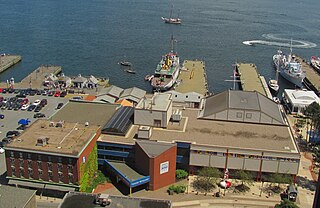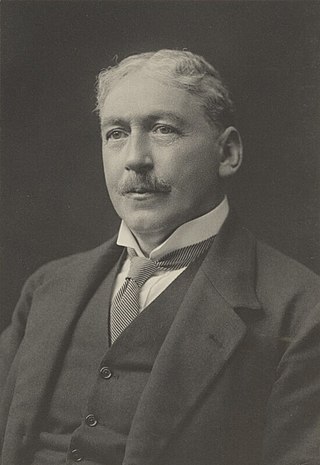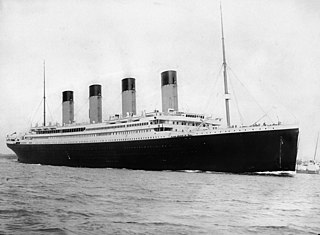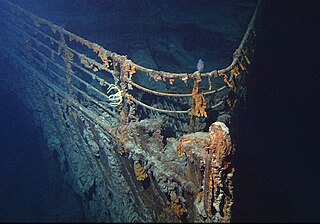Titan most often refers to:

Robert Duane Ballard is an American retired Navy officer and a professor of oceanography at the University of Rhode Island who is noted for his work in underwater archaeology and marine geology. He is best known by the general public for the discoveries of the wrecks of the RMS Titanic in 1985, the battleship Bismarck in 1989, and the aircraft carrier USS Yorktown in 1998. He discovered the wreck of John F. Kennedy's PT-109 in 2002 and visited Biuku Gasa and Eroni Kumana, who saved its crew.

The Maritime Museum of the Atlantic is a maritime museum located in downtown Halifax, Nova Scotia, Canada.

USS Scorpion (SSN-589) was a Skipjack-class nuclear-powered submarine that served in the United States Navy, and the sixth vessel, and second submarine, of the U.S. Navy to carry that name.

Henry de Vere Stacpoole was an Irish author. His 1908 romance novel The Blue Lagoon has been adapted into multiple films. He published using his own name and sometimes the pseudonym Tyler de Saix.

On April 14, 1912, the Titanic collided with an iceberg, damaging the hull's plates below the waterline on the starboard side, causing the front compartments to flood. The ship then sank two hours and forty minutes later, with approximately 1,496 fatalities as a result of drowning or hypothermia. Since then, many conspiracy theories have been suggested regarding the disaster. These theories have been refuted by subject-matter experts.

Futility is a novella written by Morgan Robertson, first published in 1898. It was revised as The Wreck of the Titan in 1912. It features a fictional British ocean liner named Titan that sinks in the North Atlantic Ocean after striking an iceberg. The Titan and its sinking are famous for their similarities to the real-life passenger ship RMS Titanic and its sinking 14 years later. Following the sinking of the Titanic the novel was reissued with some changes, particularly to the ship's displacement.
"The Thirty Fathom Grave" is episode 104 of the American television anthology series The Twilight Zone. It originally aired on January 10, 1963 on CBS. In this naval-themed episode, the crew of a Navy destroyer hear a mysterious rhythmic noise coming from a sunken submarine.

The Titanic has played a prominent role in popular culture since her sinking in 1912, with the loss of over 1,500 of the 2,200 lives on board. The disaster and the Titanic herself have been objects of public fascination for many years. They have inspired numerous books, plays, films, songs, poems, and works of art. The story has been interpreted in many overlapping ways, including as a symbol of technological hubris, as basis for fail-safe improvements, as a classic disaster tale, as an indictment of the class divisions of the time, and as romantic tragedies with personal heroism. It has inspired many moral, social and political metaphors and is regularly invoked as a cautionary tale of the limitations of modernity and ambition.
John Chatterton is an American wreck diver. Together with Richie Kohler, he was one of the co-hosts for the History Channel’s Deep Sea Detectives, for 57 episodes of the series. He is also a consultant to the film and television industries and has worked with 20th Century Fox, Paramount Pictures, and CBS.

RMS Titanic was a British ocean liner that sank on 15 April 1912 as a result of striking an iceberg on her maiden voyage from Southampton, England to New York City, United States. Of the estimated 2,224 passengers and crew aboard, 1,496 died, making the incident the deadliest sinking of a single ship at the time. Titanic, operated by the White Star Line, carried some of the wealthiest people in the world, as well as hundreds of emigrants from the British Isles, Scandinavia, and elsewhere in Europe who were seeking a new life in the United States and Canada. The disaster drew public attention, spurred major changes in maritime safety regulations, and inspired a lasting legacy in popular culture.

There have been several legends and myths surrounding the RMS Titanic and its destruction after colliding with an iceberg in the Atlantic Ocean. These have ranged from stories involving the myth about the ship having been described as "unsinkable" to the myth concerning the final song played by the ship's musicians.

The wreck of the Titanic lies at a depth of about 12,500 feet, about 370 nautical miles south-southeast off the coast of Newfoundland. It lies in two main pieces about 2,000 feet (600 m) apart. The bow is still recognisable with many preserved interiors, despite deterioration and damage sustained hitting the sea floor. In contrast, the stern is heavily damaged. A debris field around the wreck contains hundreds of thousands of items spilled from the ship as she sank. The bodies of the passengers and crew would also be distributed across the seabed, but have since been consumed by other organisms.

The RMS Lusitania was a British-registered ocean liner that was torpedoed by an Imperial German Navy U-boat during the First World War on 7 May 1915, about 11 nautical miles off the Old Head of Kinsale, Ireland. The attack took place in the declared maritime war-zone around the UK, three months after unrestricted submarine warfare against the ships of the United Kingdom had been announced by Germany following the Allied powers' implementation of a naval blockade against it and the other Central Powers.
"How the Mail Steamer Went Down in Mid Atlantic by a Survivor" is a short story that was published in the 22 March 1886, issue of the Pall Mall Gazette by the English investigative journalist and newspaper editor William Thomas Stead. Stead included this editorial comment: "This is exactly what might take place and will take place if liners are sent to sea short of boats".
The ocean liner Titanic has been extensively portrayed in films, books, memorials and museums.
On 18 June 2023, Titan, a submersible operated by the American tourism and expeditions company OceanGate, imploded during an expedition to view the wreck of the Titanic in the North Atlantic Ocean off the coast of Newfoundland, Canada. Aboard the submersible were Stockton Rush, the American chief executive officer of OceanGate; Paul-Henri Nargeolet, a French deep-sea explorer and Titanic expert; Hamish Harding, a British businessman; Shahzada Dawood, a Pakistani-British businessman; and Dawood's son Suleman.
Titan disaster may refer to:











